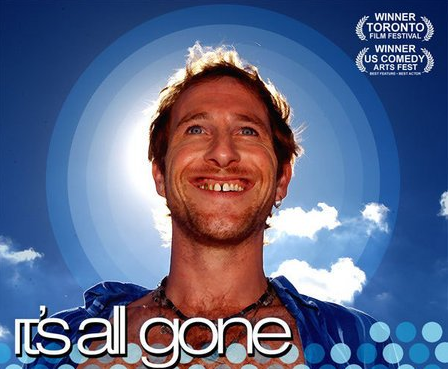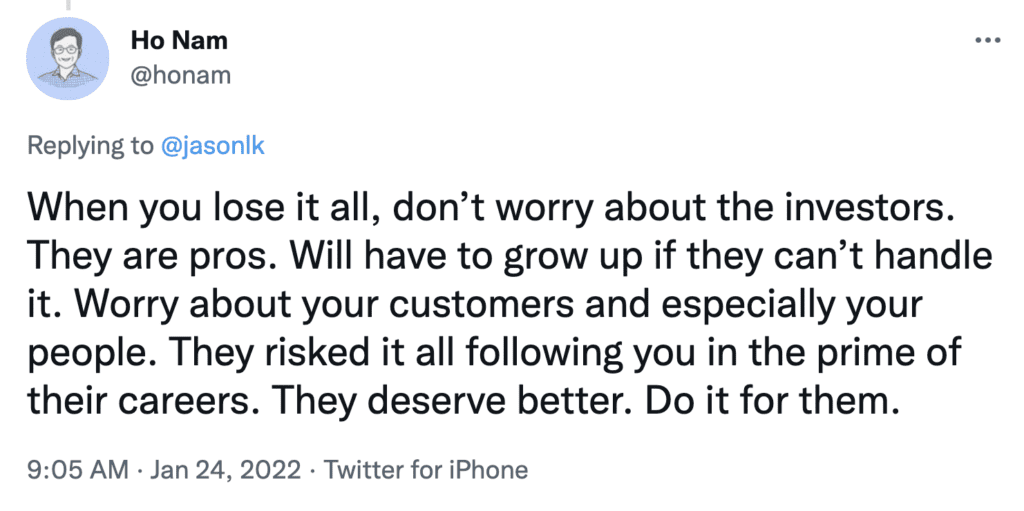In both my start-ups, I was constantly worried about losing all my investors’ money. The first time, my first start-up, which we haven’t talked much about, NanoGram Devices, I mainly worried about it because I realized we’d almost never have enough capital to achieve our long-term goals. So, FBOW, we sold for $50,000,000 after 12.5 months.
At Adobe Sign / EchoSign, it was a bit different. My investors included my old bosses, and, as time went on, myself to a material extent. When things were rough in our first 12 months, one of the main reasons I didn’t quit was because I couldn’t bear to lose their money. So that was good, in the end, that fear of losing your investors’ money. At the time, at least. It got us to our “Series B” (what would be called an early Series A today 🙂 and ultimately a pretty good exit by the standards of a few years ago at least.
But with hindsight, it’s a real negative — worrying about losing your investors’ money. Especially in SaaS. Now as an investor myself, I get it much better.
Let me explain:
- First, true seed investors know what they are getting themselves into. True seed investors know many of their investments fail, and they make (hopefully) calculated bets. Maybe, don’t take money from your mom and dad if they can’t afford to lose it. But true seed investors, the ones that make 30+ seed investments for a profit and not a hobby, and all VCs, know exactly what they are doing and what risks they are taking. Look at me now as a VC — I have about $60,000,000 from our current fund (my share) to personally invest. If I lose $250,000 on a seed investment that I truly believe in, but it didn’t played out as we all hoped … that’s a bummer. But that’s about all it is from an investor perspective. It’s a rounding error. Now, if I lose like $10,000,000 … oy. I’m in trouble then. I’m out of a job. But not on that one $250k seed investment.
- Second, in the early days, your interests are almost perfectly aligned with your seed and early investors. It’s binary here. Most every early-stage investment either makes a solid profit for the investors, or nothing at all (odd acqui-hires aside). It’s rare to make a 5.75% return on an early-stage start-up investment. So worrying about losing your investors’ money doesn’t help. We’re all in it together. Just worry about getting to Initial Traction. That’s enough.
- Third, post-Initial Traction, caring too much about losing your investors’ money will make you too risk-averse. Once you’re at $1-$1.5m in ARR or so, you can still fail. But you’ve done The Impossible. It’s time to get to The Inevitable, $10m ARR. Your biggest risk really here is not getting there fast enough. Stop living hand-to-mouth. Stop taking out the garbage yourself, if you don’t have to. Stop paying below-market salaries, and only hiring the managers you can get, not best-of-breed. Stop paying sales reps too little. Stop hiring directors instead of VPs to save money. Get it done. Make it so. Grow faster. And if that increases the risk you lose all your investors’ money, so be it.
- And later, it’s just a valuation game. I firmly believe in Mark Suster’s top end of normal. You don’t want angry investors who feel ripped off in a deal. Those scars last a long time, and disalign interests. But I mean, if investors want to invest at some soon-to-be-unicorn valuation when your start-up is doing $10m in ARR growing 200% YoY, and you want it, just take it. Don’t overanalyze it.
Mostly importantly, all you really have to worry about in the early days on the finance/capital/money side is your Zero Cash Date. When you run out of money. More on that here.
If you worry beyond that if you worry too much about the moral obligations in losing all your investors’ money … you’re just adding unnecessary stress to an already impossible task. I’m not saying spend it all in 12 months, or increase your burn to worrisome levels. Do what’s right for the business, even in these heady days for SaaS.
And seriously, make the money last. The best founders I’ve worked with have all almost failed. Even Slack had to downsize to just a few employees. But the best founders never let the company truly run out of money:
Wow forgot about this part of early Slack history:
"[Stewart] had to lay off all but eight of 40 employees. [He] set up a website called Hire A Genius and worked tirelessly to help every one of them to find another job."
It's hard early folkshttps://t.co/BPNEM66sZZ pic.twitter.com/hKkFzXHjQr
— Jason ✨Be Kind✨ Lemkin 🇮🇱 (@jasonlk) August 16, 2019
What I am saying is I know empathetic, high EQ founders that worry a lot about their investors’ capital every day. Don’t. It can hold you back. Instead, just worry about getting the world to buy millions of dollars worth of Yet Another SaaS App They’ve Never Heard Of and Managed Until Today to Survive Just Fine Without. And just try not to run out of money getting there.
(note: an updated SaaStr Classic post)


